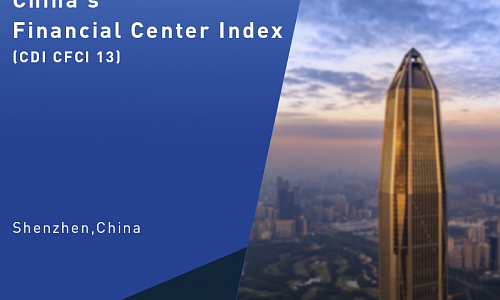
2017 - In the News
An attempt to rank financial centres according to their contribution to green finance is being launched by Brussels-based NGO Finance Watch and the London-based Long Finance initiative.
The Global Green Finance Index (GGFI) will draw on the methodology already in place for the Global Financial Centres Index (GFCI), backed by the Z/Yen think tank and the China Development Institute, which is now in its 11th year. Z/Yen manages Long Finance with support from the City of London Corporation and Gresham College.
“Green finance is no longer seen as a fringe activity, but a profitable and desirable activity, which drives financial markets, serves society and enhances the status of financial centres which demonstrate expertise,” said the GGFI backers.
Several cities have already made explicit commitments to position themselves as leaders in this fast-growing market.
The new index, which is sponsored by the MAVA Foundation – a Swiss conservation organisation – is intended to encourage cities to become greener, compare their performance with their peers, improve policy makers’ understanding of the drivers of green growth, and assist them in shaping the financial system to support sustainability goals.
The term ‘green finance’ is intended to include “any financial instrument or financial services activity – including insurance, equity, bonds, commodity and derivatives trading, analytical or risk management tools – which results in positive change for the environment and society over the long term”.
To compile the index, questionnaire responses from financial services professionals, NGOs, regulators, and policy makers will be combined with some 130 ‘instrumental factors’ that provide objective evidence of cities’ environmental credentials and contributions to green finance.
These two inputs are combined using ‘support vector analysis’ which predicts how respondents would rate cities with which they are unfamiliar.
“The problem with perception data is that individuals have knowledge of only a limited number of centres,” explained Z/Yen associate Simon Mills.
The ‘support vector analysis’ answers questions such as: “If a pension fund manager gives Paris and Sydney a certain assessment then, based on the instrumental factors for Paris, Sydney and Singapore, how would that person assess Singapore?
To avoid home centre bias, the centre that a respondent is based in will be excluded from the assessment.
Michael Mainelli, chairman of Z/Yen, said the questionnaire is due to be launched this month with data collection in January and publication of the index in March. It is then intended to repeat the exercise twice a year, as is done with the GCFI.
Examples of ‘instrumental factors’ to be used in the GGFI include:
- Banks’ ratio of green energy to high carbon energy lending
- Climate-aligned bond issuance or listings as a fraction of total
- Green equity indices
- Sustainable Stock Exchange
- Air quality data
- CO2 emissions per capita
- Metro network length
- Climate Impact Vulnerability Index
- Energy intensity of GDP
- Sustainable Cities Index
- Quality of Living City Rankings
- Corruption Perception Index
- Global Innovation Index
Province seen boosting industrial upgrading
A growing number of top global companies in the high-tech, advanced manufacturing and new-energy sectors have unveiled investment projects in South China's Guangdong Province this year, a move that experts attribute to the local government's stimulus policies and an improving business environment.
This trend will help create a complete advanced industrial chain and further promote the region's industrial upgrading, experts said. But they also said that a lack of international talent and the potential influence of the U.S. tax cut may slow down the region's structural adjustment.
In 2017, a total of 47 Fortune Global 500 companies have launched projects in Guangzhou, capital of Guangdong, with total registered capital of 38.2 billion yuan ($5.78 billion), according to the calculations of the Global Times.
In March, construction of the world's largest 8k-resolution panel factory, with an investment of 61 billion yuan, was begun in Guangzhou by Taiwan-based electronic contractor Foxconn Technology, according to a statement the company sent to the Global Times on Tuesday.
The project is the largest overseas investment in Guangzhou since China's reform and opening-up began in 1978, the statement said.
Also, a 350,000-square-meter biopharmaceutical project, funded by multinational conglomerate General Electric, is now under construction in Guangzhou, the 21st Century Business Herald reported on Tuesday.
In the first three quarters, foreign direct investment (FDI) into Guangdong surged 13.6 percent year-on-year to $16.96 billion, the highest in the country, according to data from the Guangdong Bureau of Statistics.
Song Ding, an expert at the Shenzhen-based China Development Institute, hailed the trend as a sign that Guangdong Province has gradually shaken off its previous reputation as being a center of cheap manufacturing for low-end industries.
"In contrast to the scenario several years ago when foreign enterprises set up factories in Guangdong merely to take advantage of the province's cheap production factors, the newly launched projects mostly feature middle- to high-end industries such as the Internet, new energy and aviation," Song told the Global Times on Tuesday.
Bai Ming, a research fellow at the Chinese Academy of International Trade and Economic Cooperation, agreed. He attributed the change to the "more efficient business environment in the province and stimulus policies rolled out by the local government to attract FDI."
A spokesperson for Foxconn told the Global Times on Tuesday that it only took about 50 days for the company to negotiate with relevant parties and sign the 61 billion yuan project with the local government.
On Monday, the Guangdong provincial government released 10 measures for attracting FDI, specifically aiming to entice Global Fortune 500 and high-tech companies, said the 21st Century Business Herald report.
Industrial upgrade
Bai said that the inflow of the FDI in high-end sectors is in line with the Guangdong government's plan to make emerging industries such as artificial intelligence and new energy strategic pillars of its economy.
"Guangdong's economy is transforming from being export-driven to being innovation-based, and the arrival of foreign high-tech companies will accelerate this process and boost Guangdong's global competitiveness," Bai said.
Terry Gou, CEO and chairman of Foxconn, was quoted as saying in the statement that the panel factory in Guangzhou is not "merely a panel processing factory."
The factory will also help encourage hundreds of upstream and downstream electronic suppliers to move their businesses to Guangzhou, creating a new industrial group valued at about 1 trillion yuan, Gou noted.
"Following the flock of enterprises in related industrial chains and value chains into Guangdong, a complete industrial chain in high-end industries will be formed," Song said.
But experts warned that the lack of international talent may hinder the cultivation of new economic growth engines.
"Most of the talent in Guangdong is from China… there is apparently a lack of diversity in talent compared with Silicon Valley in the U.S.," Song said.
Besides, the upcoming U.S. tax cut, which will reduce the U.S. corporate tax rate to about 20 percent from the current 35 percent, may also hinder U.S. firms' willingness to move their plants to Guangdong, and might prefer to operate in the U.S. instead, Bai noted.
New calculation methods see the city’s GDP figure for 2016 rising to more than US$302 billion
Shenzhen had the largest economy in southern China’s Guangdong province last year after a new method of calculating gross domestic product saw it overtake local rival and provincial capital Guangzhou.
The provincial statistics bureau said on Tuesday that it had revised up Shenzhen’s GDP figure for 2016 to more than 2 trillion yuan (US$302 billion) from 1.95 trillion yuan in its initial report. The revision meant that the city’s economy grew 9.1 per cent year on year.
Guangzhou’s GDP figure was also revised up, to 1.98 trillion yuan from 1.95 trillion yuan, but the increase was not enough for it to hold on to the top spot.
The changes meant that the province’s total economic output also rose – to 8 trillion yuan from 7.4 trillion yuan – but no figure was given for the rate of growth.
The bureau said the changes reflected the province’s decision to categorise research and development spending as fixed investment rather than an operating expense.
Guo Wanda, vice-president of the Shenzhen-based think tank China Development Institute, said: “It’s positive news for Shenzhen but not a surprise because Shenzhen has been leading Chinese cities in R&D spending.”
Last year, the city invested more than 80 billion yuan in research and development, accounting for about 4.1 per cent of its GDP, the highest ratio among mainland cities, according to official data.
Since 2013, Shenzhen has allocated more than 4 per cent of its annual GDP to R&D, putting it on a par with South Korea and Israel. By contrast, Hong Kong spends about 1 per cent of its GDP on R&D each year.
“It’s very possible to see Shenzhen’s economic size surpassing [that of] Hong Kong and Guangzhou as the Greater Bay Area shifts from a manufacturing economy to a knowledge economy more dependent on the often abstract products of innovation,” Guo said.
Ahead of Guangzhou’s Fortune forum that is expected to bring a host of global business leaders to the city from Wednesday, security checks at subway stations have been stepped up, walls repainted and even paving stones dug up and replaced.
The guests will include Ford Motor’s executive chairman Bill Ford, HSBC CEO Stuart Gulliver and leading tech entrepreneurs, including Tencent chairman Pony Ma and Alibaba founder Jack Ma. E-commerce giant Alibaba Group owns the South China Morning Post.
Local authorities hope the line-up of big-name executives will help put Guangzhou on the radar of global investors, especially Fortune 500 companies, at a time when China is struggling to attract foreign direct investment.
Lin Jiang, a professor at Lingnan College, part of Sun Yat-sen University, said local authorities were keen to make Guangzhou a base for emerging industries and were exploring ways to encourage giant global enterprises to invest. The aim, he said, was to make the city a hub for international shipping, aviation, and scientific and technological innovation.
Fixed direct investment in Guangdong in the first half of 2017 rose 6.6 per cent year on year to US$12.31 billion, according to official figures. The number of foreign-invested enterprises granted approval to set up operations in the province in the same period rose 46.4 per cent from the first half of last year to 5,239.
In Guangzhou alone, foreign investment in the first nine months of this year rose by about 13 per cent from the equivalent period of 2016 to US$5.63 billion.
“Guangzhou hopes to encourage FDI in modern manufacturing and emerging industries, but it’s facing fierce competition from nearby cities,” Lin said.
Inclusion of R&D spending in GDP calculations means mainland city may soon overtake its illustrious neighbour
Once a small fishing village on the outskirts of Hong Kong and not so long ago a haven for manufacturing sweatshops, Shenzhen, in southern China’s Guangdong province, might very soon overtake its illustrious neighbour in economic terms.
In the first three quarters of 2017, the boomtown’s economic output rose 8.8 per cent year on year to 1.54 trillion yuan (US$232.66 billion). While the figure fell short of Hong Kong’s HK$1.94 trillion (US$248.27 billion) for the period – up about 7 per cent in nominal terms from the first nine months of 2016 – the gap between the pair is narrowing.
What’s more, an official from the Shenzhen statistics bureau, who declined to be named, told the South China Morning Post that the city’s economy was set to receive a significant boost as a result of a revision to accounting methods.
“In the fourth quarter, we will follow the provincial statistics department’s lead in using a new method of calculating gross domestic product to revise up Shenzhen’s economic figures for the year,” the person said.
On Tuesday, the Guangdong statistics bureau released revised economic figures for 2016 for its major cities and the province as a whole. The changes followed a ruling from Beijing that when calculating GDP, officials should regard spending on research and development as a fixed investment rather than an operating expense.
As a result, Shenzhen, which is home to numerous technology firms, including giants Tencent, Huawei and DJI, all of which are known for their massive spending on R&D, saw its 2016 GDP figure rise by about 60 billion yuan to 2.01 trillion yuan. Such was the increase that it overtook Guangzhou as the largest city economy in the province.
Assuming it maintains the growth rate it achieved over the first three quarters, Shenzhen’s nominal GDP for the whole of 2017 would be 2.19 trillion yuan, or US$330.86 billion.
Hong Kong’s GDP for 2016 was HK$2.49 trillion. Assuming it, too, maintains its nine-month growth rate of about 7 per cent, the total for 2017, again in nominal terms, would be HK$2.66 trillion, or US$340.41 billion, or less than US$10 billion more than Shenzhen’s.
“Based on the current situation, it’s only a matter of time – maybe next year or the year after – before Shenzhen’s economy overtakes Hong Kong’s,” Simon Zhao, founding director of the International Centre for China Development Studies at Hong Kong University, said.
Despite the gains in the headline figures, it could be some time before Shenzhen overtakes Hong Kong in terms of GDP per capita, however. In 2016, the figure for Hong Kong was HK$339,000, or nearly twice that of Shenzhen.
One of the main reasons for Shenzhen’s stellar economic growth is that most companies based there are either privately owned or foreign-funded, according to Qu Jian, deputy director of the think tank, China Development Institute, which is also located in the city.
Such firms tend to be more innovative and willing to take risks, which has helped to drive technological innovation and industrial restructuring in the city faster than anywhere else in China, he said.
The combined value of Shenzhen’s six strategic industries – biotechnology, information technology, new energy, telecommunications, cultural and creative, and new materials – rose 10.5 per cent in 2016 to 780 billion yuan, or close to 40 per cent of gross domestic product.
Last year, Shenzhen invested more than 80 billion yuan in research and development, or about 4 per cent of its GDP, the highest proportion of any Chinese city.
Since 2013, Shenzhen has allocated more than 4 per cent of its annual GDP to R&D, putting it on a par with South Korea and Israel.
Despite the perceived rivalry between the two cities, ties between Hong Kong and Shenzhen are strengthening.
Tencent is now regarded as the most important stock on the Hong Kong market, while DJI, the world’s largest drone maker, was founded by Wang Tao, who studied at a Hong Kong university.
“Integration is the best way for both Shenzhen and Hong Kong to grow their tech and finance industries,” Zhao said.
“But they also face their own individual risks. Shenzhen, for instance, must be alert to issues of overcapacity in the manufacturing of drones, robots, smartphones and other electronic products, while Hong Kong is prone to changes in foreign markets, like US’ interest rate hikes and capital outflows.” he said.
Zhao said that due to fears of economic bubbles within China there were likely to be huge capital flows moving southwards from the mainland into Hong Kong next year.








